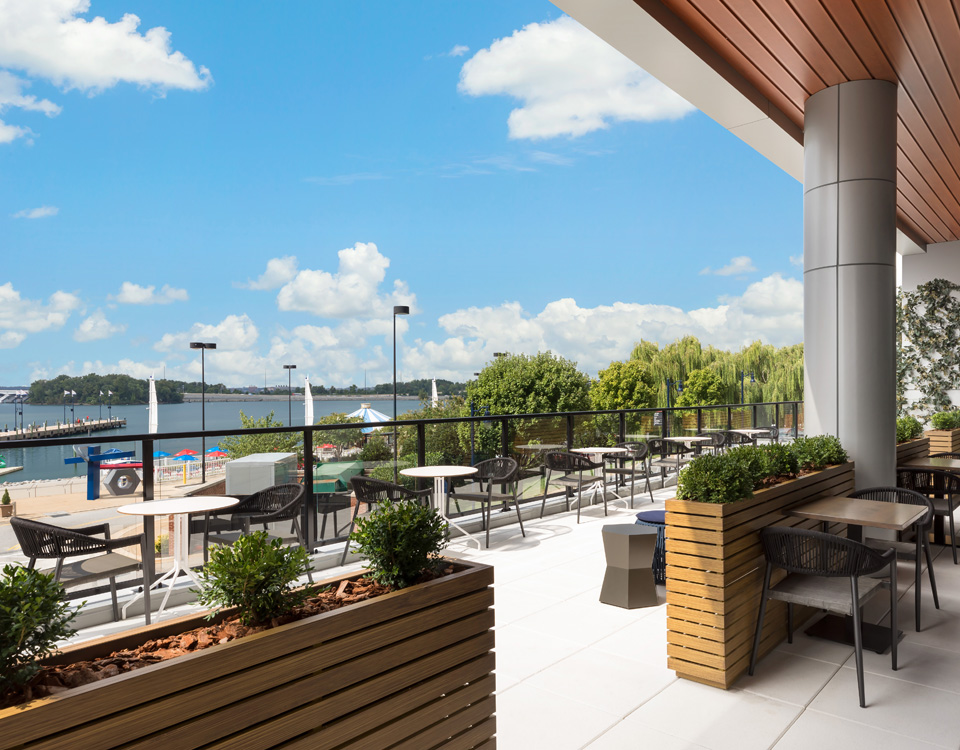To offset the transport-related emissions created by the global tourism industry, hotel designers have taken a green approach to construction and design — even during a global pandemic. According to numbers from the World Tourism Organization and the International Transport Forum, emissions from different modes of tourism transport are expected to account for over 5% of all man-made CO2 emissions by 2030.
Samuele Sordi, chief architect at Pininfarina of America, said in an email interview that his company and others in the industry seek to lower the negative impact and "actively work together to reduce greenhouse gas emissions."
They are working together through organizations such as the International Tourism Partnership and the World Travel & Tourism Council, he said. Some use the Hotel Carbon Measurement initiative, which helps hoteliers calculate their property's carbon footprint and set reduction goals.
Guests Want Eco-Friendly, Luxurious Experiences
Not only are sustainable design efforts good for the environment, they also serve as a way to attract guests as more travelers are looking for an "ethical, ecological and luxurious experience," Sordi said. Consumer interest in sustainability is shifting toward self-care as well as physical and mental well-being, he said.
"In response, the hospitality industry is designing experiences and products to meet these needs," he said. "Designers and operators in the sector must be up-to-date and aware of the progress of development and innovations to be used in the rooms and services of the hotels of the future. The evolution of hotel design will be featured by products that will aim at the emotional well-being of users and harness the power of emotionally intelligent technologies."
Sustainable design also extends to the artwork in hotels. Terry Eaton, president and chief curator of Eaton Fine Art, said in an email interview his company has collaborated with many interior design firms "to ensure environmentally responsible design practices."
"Over the years, we’ve curated art programs that include frames made from 92% recycled materials and art printed on Forest Stewardship Council-certified paper," he said. "We pride ourselves in collaborating with artists who have implemented recycled materials into their work, such as reused toilet paper rolls, reclaimed tennis rackets and repurposed bird seed sacks."
Sustainable Shifts Made During the Pandemic
A green hotel project starts by "examining the project at hand to evaluate best practices," David Tracz, co-founder and principal at design firm //3877, said via email interview. From there, his team uses local vendors and sustainable materials to construct a hotel while taking into account the project's impact on the overall footprint of the local landscape, he said. Tracz said the LEED-certified Hyatt Place National Harbor in Forest Heights, Maryland, is the most recent hotel project the firm worked on where these sustainable initiatives were put in place.
The firm's designers considered energy efficiency in the architectural design as well as in all the building systems, including the mechanical infrastructure, plumbing design and electrical distribution, he said. The hotel was conceived in 2017 and 2018, before the pandemic and social distancing protocols. While the hotel wasn't built with those things in mind, it was able to adapt and accommodate guests safely as the property has a "generosity of space" and was able to take advantage of "outdoor living," he said.
Prasoon Shrivastava, founder and CEO of Prasoon Design Studio, said in an email interview his firm takes into account the impact hotel design will have on "the natural environment, community, local culture and human interaction within built environments. "Prasoon Design Studio leverages technology and bioclimatic design elements in its projects and is "mindful of the environment, beginning from the design conception stage," he said.
"We ensure that the built environment includes efficient heating, cooling and lighting while minimizing the carbon footprint," he added. Nelson Worldwide oversaw two hotel projects with LEED certification that had sustainable design standards it had to adhere to to meet requirements for the certification, design director Cheryl Smith said in an email interview.
One of the clients made one major change to its air filtration system during construction because of the pandemic to help guests feel safer. "They installed an air filtration system known as bipolar air ionization to the duct work within the public spaces, which helps to kill bacteria and viruses by reducing allergens," she said.
Pablo La Roche, principal at CallisonRTKL, said via email that since research shows its safer to be outdoors than indoors, hoteliers and designers should use "microclimate strategies to make their outdoor spaces as comfortable as possible."
"We often leverage microclimate design and condition spaces in a sustainable manner," he said. "Whether it's through passive solar heating, air movement, evaporative cooling, shade, photovoltaic panels, on-site sorting and waste management or rainwater harvesting, we approach indoor and outdoor holistically and sustainably."
Off-Site Manufacturing, Local Supply Chains
Mohammed Adib, chief design officer at Dewan, said via email that one of the most important advancements to reduce the impact on the environment is off-site manufacturing over traditional site construction — often referred to as pod construction.
Moving materials from a facility to a building site could increase the carbon footprint due to increased transport, but "this is more than offset by the savings and improvement that a factory controlled production can offer, as well as the more limited impact on the actual construction site," he said.
Adib said his firm is currently working on two hotel projects on the western coast of Saudi Arabia where the client chose to go with off-site manufacturing to maintain as much nature as possible surrounding the Red Sea where the sites are located. The projects are maintaining the natural surroundings by limiting the work in and around the site and bringing in almost complete guestroom villas to the site.
"Pod construction for other projects is almost the norm now, and the process is continuing to evolve to build increasingly larger units off-site," he said. TPG Architecture takes a holistic approach to sustainable design, said said Shay Lam managing executive and studio creative director, via email.
They often find strategies in the base of the building itself through having greater access to natural light and air, products that use less electricity and water and systems that are more efficient to produce. "We are especially looking at local supply chains, which dramatically cut down on fuel and byproducts of shipping," he said.
Adaptive Reuse
Another way to be more environmentally conscious is to "reuse our existing building stock whenever possible," said Dwayne MacEwen, founder and creative director of DMAC Architecture, in an email interview.
He said the Graduate Evanston in Evanston, Illinois, is one example of this. The hotel was built in a historic building that needed major upgrades to bring it up to code and provide for the needs of guests.
"Though this historic building was locally protected, it could have easily been demolished in other circumstances," he said. "Instead, our goals were to bring light to the building’s unique details and spaces while adding modern infrastructure for greater longevity."


